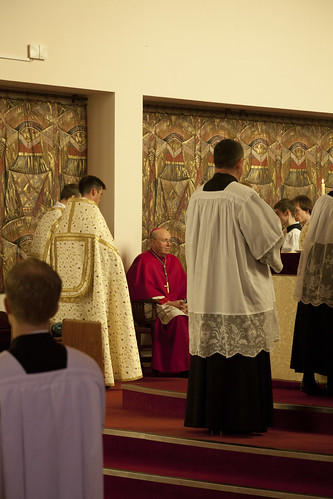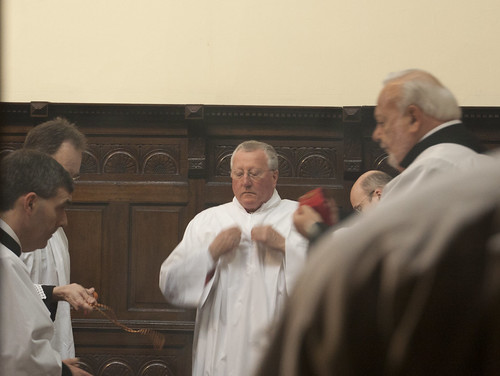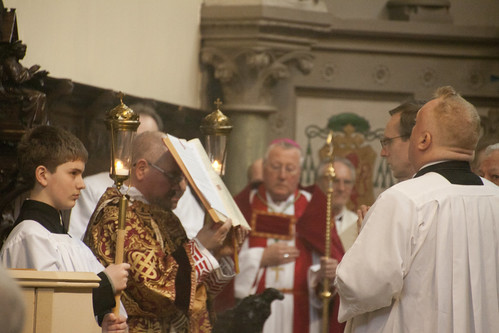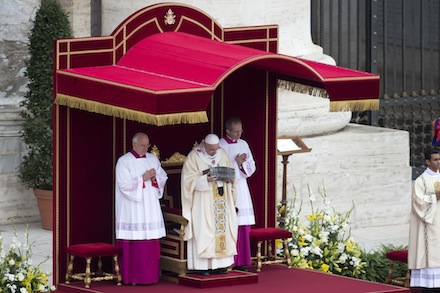
Mgr Basil Loftus excels himself in last weekend's column: The Catholic Times, 24th November 2013.
'These excesses [French monarchism, the Order of St Lazarus] are fortunately peripheral in Britain, but we do see churches dedicated exclusively to the celebration of the Tridentine-rite liturgy which sometimes ignore strict prohibitions on the use of thrones and canopies, on the vesting of bishops in the sanctuary rather than in the sacristy, on the washing of a bishop's hands with Jeeves-like servants and on the continuing cult of non-existent saints such as Philomena, who has been banned from every calendar in the world, only to become a cult figure for the opponents of liturgical reform. The totems of opposition to post-conciliar Kingdom liturgy are erected in several places where Tridentine-rite liturgy is permitted, even here in Britain.
Now hang on a minute. Under certain conditions, according to the 1962 books specified by the legislation governing the Extraordinary Form, bishops can vest in the sanctuary. Those are the rules. It is not 'strictly forbidden': that is a fantasy. Anyway, I though Loftus hated it when people insisted on rubrical exactness? Oh, only selectively. When it suits him, he uses imaginary liturgical legislation to attack some of our English bishops: shown here are Bishop McMahon of Nottingham, and Bishop Drainey of Middlesbrough. Are they dangerous extremists, Mgr? (The places these Masses are taking place, incidentally, are not even regularly used for the EF, let alone exclusively: the chapel of Ratcliffe College, and St Wilfrid's in York.)
 |
| Bishop McMahon vests in the Sanctuary: more photos |
(I've addressed Loftus' drivel about St Philomena here.)
 |
| Bishop Drainey, presiding at High Mass for the LMS York Pilgrimage in 2012: more photos |
 |
| Vesting in the sanctuary |
Here Loftus is presumably referring to the famous 'stable group' rule, which allows groups of those attached to the Traditional Mass to come together from different parishes, rather than ask for several Masses in several places. It seems quite sensible to me: and it is in the original legislation, Summorum Pontificum (Article 5); it's not something added later by the PCED.
 |
| Listening to the Gospel, fully vested. |
Loftus goes on:
The Commission's sometimes sententious decisions which then followed also inhibit the free discussion among the People of God which helps to build a liturgy, old-rite or new, which is sensitive to the needs of time and place. It is simply arrogant and unjust for altar-girls to be forbidden the Tridentine-rite Masses. More and more there is an unjustified presumption that Communion at such Masses may only be received kneeling and on the tongue.'
Clearly, if you took the 1962 books and applied to them all the changes which happened afterwards you'd end up with the Ordinary Form. What would be the point of that?
As far as the PCED is concerned, what Loftus needs to get over is the final article of Summorum Pontificum:
Art. 12. The same Commission [sc. Ecclesia Dei], in addition to the faculties which it presently enjoys, will exercise the authority of the Holy See in ensuring the observance and application of these norms.
Tough luck, mate. Oh, and here's more tough luck. If you think that Pope Francis is going to conduct some kind of fanatical campaign against canopies, you're in for a disappointment.


Another brush with Basil?
ReplyDeleteEven leaving aside the EF and focusing only on the OF, Msgr. Loftus is incorrect in his statement that there are "strict prohibitions on the use of thrones and canopies."
ReplyDeleteThe revised Ceremonial of Bishops (#47) provides for what is a throne in all but name: a chair that stands alone, is used only by the diocesan bishop (or another bishop he permits to use it) and is elevated on steps if necessary so that the people can see the bishop.
The Ceremonial says that "There is to be no baldachin over the bishops chair; but valuable works of art from the past are to be preserved with utmost care.
Ergo, as we say in the US: "If you like your throne with a baldachin you can keep your throne with a baldachin." This is rather less than an absolute prohibition.
The Bishop McMahon in those photos is bishop of Nottingham, not Northhampton.
ReplyDelete